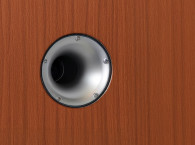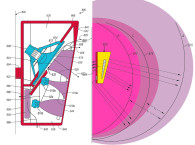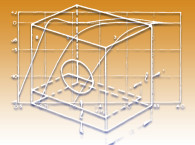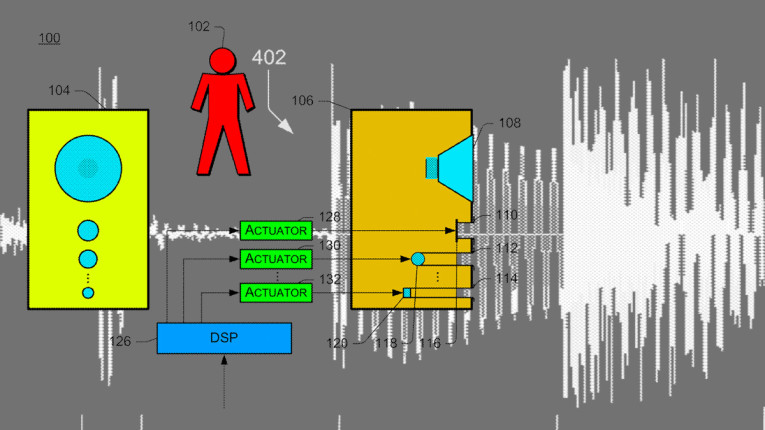
Smart Bass Reflex Loudspeaker
Patent Number: 9,615,163
Inventor(s): Ramez Nachman (Seattle, WA); Mohammed Aftab Alam (San Jose, CA)
Assignee: Amazon Technologies, Inc. (Reno, NV)
Filed: December 20, 2013
Current CPC Class: H04R 1/2826
Granted: April 4, 2017
Number of Claims: 20
Number of Drawings: 8
Abstract from Patent
A loudspeaker port may include tunable physical components to tune the port to different frequencies to improve speaker efficiency at those frequencies. The ports may be activated by at least partly opening associated shutters, or disabled by closing the associated shutters. Activated ports may enhance speaker efficiency in a frequency range. However, activated ports may also introduce sound artifacts, thereby reducing sound quality. Therefore, the ports may be disabled when appropriate to reduce their negative impact to sound quality. A digital signal processor (DSP) may determine the frequency components of a played sound to determine when to open the ports and how to tune the ports. Accordingly, a loudspeaker may benefit from the improved efficiency facilitated by the ports while also avoiding typical drawbacks created by the ports.
Independent Claims
1. A method for selectively tuning a port from a plurality of ports of a speaker, the method comprising: receiving an audio signal, the audio signal including a plurality of audio signal components, wherein an individual audio signal component of the plurality of audio signal components has an associated frequency; analyzing, by the speaker, the audio signal to determine a first audio signal component to be output from the plurality of audio components, the first audio signal component having an associated first frequency, analyzing the audio signal comprising performing a Fast Fourier Transform (FFT) of the audio signal; selecting, based at least in part on the first frequency, a first port from the plurality of ports for tuning, wherein: the first port is tunable within a first frequency range, the first frequency being within the first frequency range; and a second port of the plurality of ports is tunable within a second frequency range based at least in part on received audio signals; tuning the first port to the first frequency to output the first audio signal component, wherein tuning the first port comprising one or more of: changing a shutter position of a shutter coupled to the first port; changing a length of the first port; or changing a cross-sectional area of the first port; and outputting sound represented by the audio signal.
4. A method for tuning a plurality of ports of a speaker, the method comprising: analyzing an audio signal to determine a frequency component of the audio signal; selecting, based at least in part on the frequency component, a first port to tune from the plurality of ports of the speaker, the first port being tunable within a first frequency range, wherein the frequency component of the audio signal is within the first frequency range; tuning the first port to the frequency component, wherein tuning the first port comprises changing at least one or more of: a shutter position of the first port, a length of the first port, or a cross-sectional area of the first port; deactivating at least a second port of the plurality of ports; and outputting sound represented by the audio signal.
Reviewer Comments
As I have mentioned a number of times over the years, a key problem, and opportunity, with resonant tuned systems, such as Helmholtz bass reflex, or resonant wave column systems, is that while they dramatically reduce transducer displacement for a given sound pressure level at the tuning frequency (FB) they require very high displacement to maintain the same SPL at 1.4 x FB and, at and below 0.82 FB.
Often, the practitioners of bass reflex systems (and other Helmholtz or wave column woofer systems) are concerned about distortion due to over-excursion below FB, and often address this with a high-pass filter in active systems. But, rarely do they address, or even mention, the increased displacement within the passband at 1.4 x FB.
D. B. Keele, Jr., in his great papers on bass reflex alignments, and specifically in “Direct Low-Frequency Driver Synthesis from System Specifications,” Journal of the Audio Engineering Society (JAES), Volume 30, No. 11, November 1982, attempted to show how smaller woofer vented systems can equal large woofer sealed systems, illustrating equivalent maximum acoustic output capability in the passband when comparing a 15” woofer in a second-order sealed box and an 8” woofer in a sixth-order vented enclosure, with the same enclosure volume, cutoff frequency (FC), and linear excursion (Xmax) limit (differing only in efficiency). But in reality, one finds that while the maximum linear outputs over a narrow range centered at FC will be comparable, at approximately 1.4 × FC, the vented system will be limited to 10 dB less output than the sealed system. With drivers of the same effective surface area and Xmax in both systems, the output would be comparable at 1.4 × FC. The issue is that even with the substantial displacement reduction in a vented system at FB the output in the passband is significantly limited by the excursion requirements at 1.4 × FB, and as mentioned in previous reviews, with dual-tuned bandpass systems, the maximum output capability will be reduced even more (~3 dB) in this range.
One approach to the situation might be to have an adaptive tuning frequency that may better support high program output at displacement-vulnerable frequencies. This vulnerability in vented systems is rarely mentioned, or addressed, but recently a few companies have attempted to make systems with adaptive port mass to affect a dynamic tuning frequency, which can be responsive to the spectral content of the program material.
One of the earliest and most basic approaches of this type was disclosed in Japanese Patent Application No. 06-326416, “A Sound Control Device,” filed December 27, 1994. This was a static device that allowed port mass to be “manually” switched to different values based on knowing ahead of time what the program material will be. Obviously, except for special cases, this static approach would not be a particularly useful device, but it was at least an attempt to address the issue.
More recently, attempts to develop real-time, dynamic port mass control systems have been explored, as disclosed in US 2009/0122998, “Vented Loudspeaker Box System and Its Control Method,” by Stephan Willems and assigned to Philips Electronics, comprising a program content analyzer in combination with a motorized vent length controller to vary acoustic mass resulting in the adaptation of the tuning frequency to the low frequency range of greatest signal amplitude. Due to problems with motor noise and complexity costs, additional passive techniques for varying acoustic mass by way of changing vent length were explored and disclosed in European patent WO2009/118677, “Vented Loudspeaker System,” by the prolific team of Ronaldus Aarts, Joris Nieuwendijk, and Okke Ouweltijes, also assigned to Philips Electronics. These systems were apparently found to be impractical, since all the related patents were eventually abandoned.
As an alternative approach to dynamically adapting the tuning frequency of a bass reflex system, Joseph Pinkerton of Clean Energy Systems adapts the concept to a passive diaphragm radiator in US application 2017/0105065 “Passive Radiator With Dynamically Adjustable Resonant Frequency,” filed October 10, 2016.
In this case, the loudspeaker received the program signal and applied a delay to it before it is reproduced by the system, providing the tuning frequency controller with a look-ahead ability to determine the dominant program bass note (or notes) before altering the compliance and/or mass of the passive radiator so that by the time the dominant bass note is reproduced by the loudspeaker, the tuning frequency of the passive diaphragm radiator will be aligned with the peak energy frequency of the program material. (See the patent review in the June 2017 issue of Voice Coil.)

This most recent patent under review here discloses a similar technology developed for Amazon, most likely as a low-frequency improvement for future versions of the Amazon Echo loudspeaker/communication system. One of the differentiators of the new system relative to similar prior art is that of using multiple ports of differing acoustic mass, and having the choice to activate one port, or two ports in parallel, or to close off both ports, operating the system in an acoustic suspension mode when desired. One or more of the ports may also be adjustable in acoustic mass, providing even more combinations to achieve a desired tuning frequency (see Figure 1 and Figure 2).
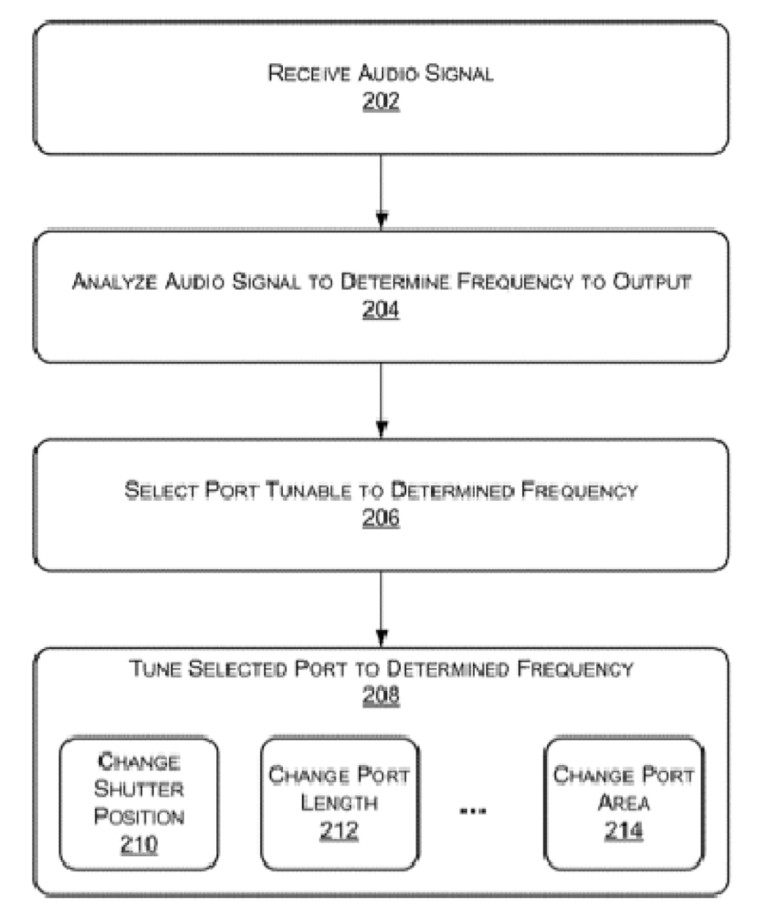
Described are various techniques to tune a port of a loudspeaker and to selectively enable the port to be open, or closed (non-functioning) using a mechanical high-speed shutter. Tuning the port frequency may be accomplished by changing one or more physical properties of the port, for example, by varying the length of the port, opening the shutter to varying degrees of openness, and varying the cross-sectional area of the port.
When the shutter is open, the port may be activated in a predetermined mass configuration and may enhance speaker output capability in the frequency range corresponding to the resonant frequency of the tuned port. When the shutter is closed, the port may be deactivated, with the inventor’s stated goal of reducing or eliminating the port's negative influence on sound properties (e.g., transient response, undesired resonance, and the like). Furthermore, a deactivated port may be used to improve speaker efficiencies in other ranges, such as mid- or high-frequency ranges, or to eliminate overload below the tuning frequency of an open-shutter port, particularly if the adaptive port cannot tune the system below a certain frequency.
The signal processing may equalize sound output to adapt the resulting, momentary, adapted-port response, to maintain a desired response curve or change to a preferred momentary response curve depending on program and loudspeaker conditions.
As one reads through the patent, it starts out very interesting, with some clear differentiations relative to previous systems of this type. But, the more one reads, the more it seems as if the inventors have not actually built one of these systems and also that they don’t have an understanding of the acoustical principles involved.
While there is much discussion of implementation relative to activating different functions of the system, there is very little discussion of the psychoacoustics, or loudspeaker design issues and related outcomes. One basic concept that appears to be misunderstood is that it is claimed that the more ports they open up in parallel into the single enclosure chamber, the lower the tuning frequency and the greater the low-frequency output. Of course, if you apply two ports in parallel, the acoustic mass actually is lowered, and the tuning frequency is raised (the opposite of what is shown in Figure 3). There will be lower losses with two ports in parallel, but that becomes a useless advantage when the frequency is moved up and port velocity requirements are reduced.
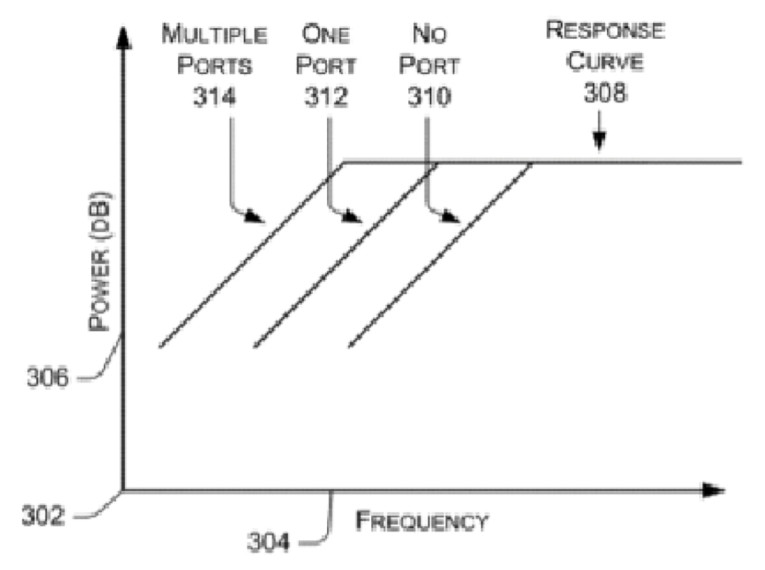
Other disclosures, or lack thereof, also bring the system into question. There is no discussion of turbulence, even though one of the recommended use models is to vary the shutter to different percentages of closure across the cross sectional area of the port. It might be a great way to make a whistle, but probably not the best method to vary the acoustic mass of a high velocity port. There is also no discussion of the attack and release times and the potential resulting distortion. This type of system dynamic usually requires a slow release time, particularly at the low frequency of operation, if one wishes to avoid audible pumping distortion.
There is also no discussion of the displacement and excursion implications of the primary active transducer when applying a system of this type, which is a primary reason for implementing this technique in the first place. Last, there is no discussion of latency issues with a system of this type, which tends to rely on significant delays to provide an adaptive look-ahead capability to function effectively on rapidly changing, dynamic program material (see Figure 4). It is possible, that the lack of discussion of these elements is just the nature of engineers working with patent attorneys and the message not being effectively conveyed into the drafting of the application.
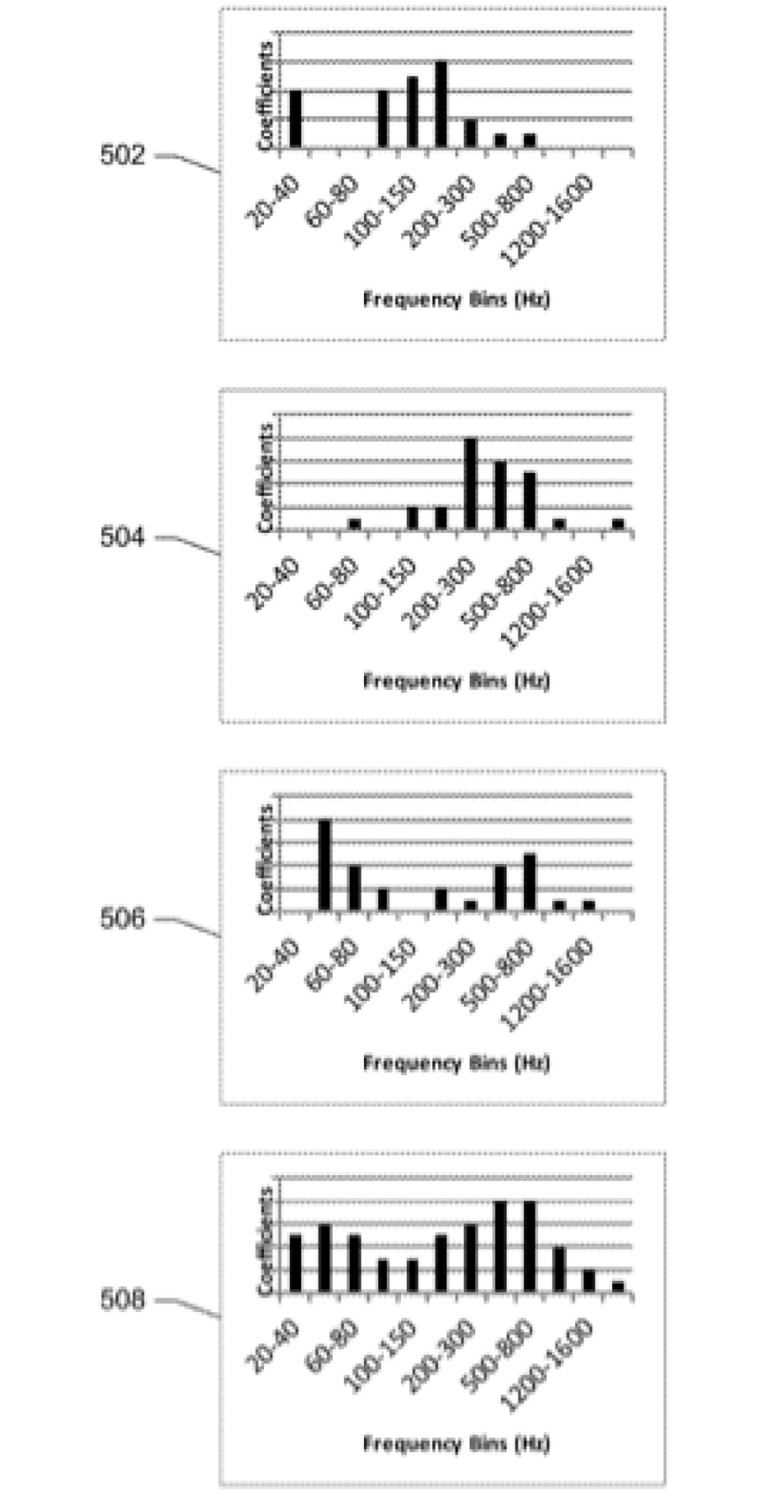
As with the past attempts by Philips and others to make this type of system practical, one would like to think there is a way to realize a working model that achieves the desired advantages without creating negative, secondary effects that swamp any gains that might be possible. I’m always enthusiastic when I see someone attempt to develop this type of solution. Hope springs eternal…but with a skeptical eye. VC
This article was originally published in Voice Coil, June 2018.



